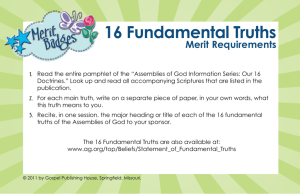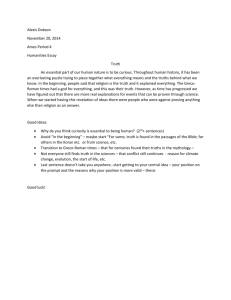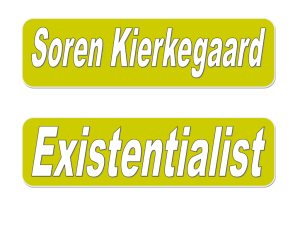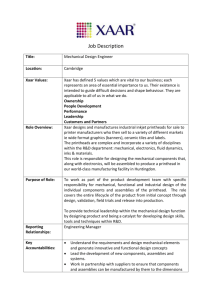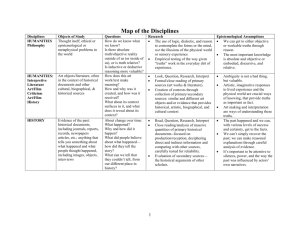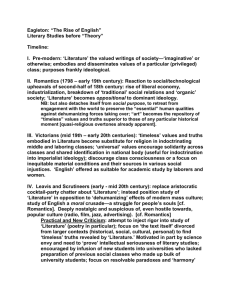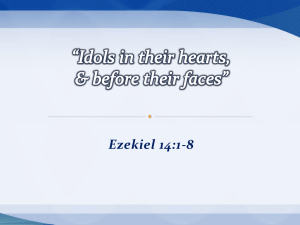The Statement of Fundamental Truths was adopted in 1916 and
advertisement
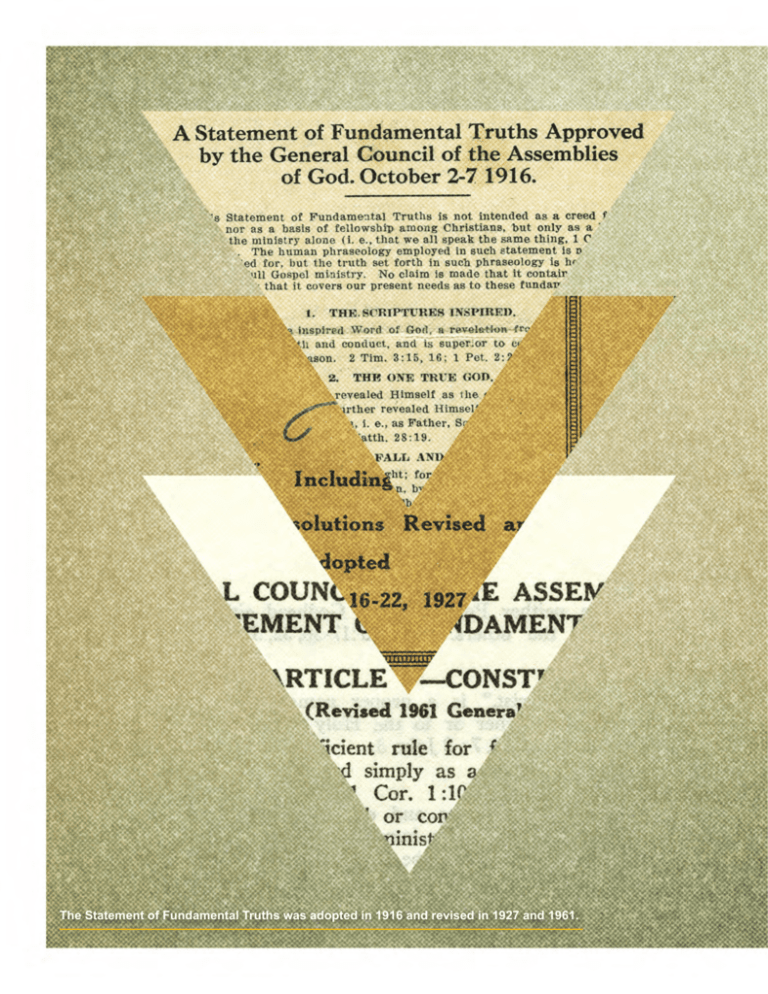
The Statement of Fundamental Truths was adopted in 1916 and revised in 1927 and 1961. The Historical Development of the Statement of Fundamental Truths By Glenn W. Gohr The Statement of Fundamental Truths provides the “basis of fellowship” for the Assemblies of God.1 Since its adoption at the fourth General Council in 1916, amidst doctrinal controversies that threatened to undermine the young organization, the Statement of Fundamental Truths has brought both definition and unity to the Fellowship. Despite the significance of the Statement of Fundamental Truths, scholars have largely ignored its historical development. Various scholars have treated the document ahistorically — incorrectly asserting that the statement during its first 45 years either remained unchanged or had only minor grammatical changes.2 Although the core beliefs outlined in the document are essentially the same today as in 1916, the statement has been revised a number of times throughout the years.3 This article provides an overview of many of these changes. The Statement of Fundamental Truths has become an integral part of Assemblies of God identity. Numerous articles and books have been written concerning the core beliefs contained within the Statement of Fundamental Truths. The statement is foundational to ministerial preparation and credentialing. Undergraduate and graduate courses covering the history and polity of the Assemblies of God pay great attention to the Statement of Fundamental Truths. “Foundations for Faith,” a course for the sixth grade based on these fundamentals, served an important catechetical function for over 30 years. The latest teaching version of that class is Faith Case: Investigating the Truth, which includes a contemporized DVD format to teach these basic beliefs to children. Royal Rangers and Girls Ministries offer the Statement of Fundamental Truths as part of their curriculum. Similar studies have been developed for membership and new converts classes. A synopsis of the statement has appeared for years inside the Pentecostal Evangel and also appears on the Assemblies of God website.4 This statement developed by the Assemblies of God USA also became the framework for statements of faith adopted by the Pentecostal Assemblies of Canada,5 the Philippines General Council of the Assemblies of God, the Assemblies of God of Malaysia, and other national organizations.6 Early Doctrinal Unity and Diversity At the inception of the Assemblies of God in 1914, the founders recognized the need to encourage doctrinal unity. The first of the five stated reasons for organizing at Hot Springs was: FIRST: We come together according to Acts 15, that by prayer and study of the Word of God, and guidance of the Holy Spirit, we may get a better understanding of what He would have us teach, and thus do away with many divisions over doctrines and various names under which the Pentecostal people are working and incorporating, — UNITY being the chief aim.7 A few doctrinal resolutions were passed before 1916. Among these was the Preamble and Resolution of Constitution, adopted at the first General Council in April 1914, which stated that the Fellowship should: recognize Scriptural methods and order for worship, unity, fellowship, work and business for God, and to disapprove of all unscriptural methods, doctrines and conduct, and approve of all Scriptural truth and conduct, endeavoring to keep the unity of the Spirit in the bonds of peace, until we all come into the unity of the faith, and of the knowledge of the Son of God, unto a perfect man, unto the measure of the stature of the fulness of Christ, and. to walk accordingly, as recorded in Eph. 4: 17-32 …8 At the 1915 Council it was necessary to lay some ground rules on doctrinal matters, including the formula to be used in water baptism as well as official statements regarding the new birth and the godhead.9 A more complete doctrinal statement was adopted in 1916, and the actual constitution was ratified in 1927. The emergence of the Oneness movement (also known as the “New Issue”), which denied traditional Trinitarian formulations, served as one of the catalysts for the adoption of the Statement of Fundamental Truths. The Oneness movement originated, in part, at the Worldwide Camp Meeting at Arroyo Seco, near Los Angeles, in April 1913. At a baptismal service held near the main camp, R. E. McAlister reminded the listeners that the apostles baptized their converts in the name of Jesus. One preacher warned him to refrain from emphasizing that doctrine as it might associate the camp with a Dr. 2012 AG HERITAGE 61 Sykes who was currently baptizing his converts in that same manner.10 Another minister in attendance, John G. Scheppe, spent much of the night in prayer, and in the early light of the morning he shouted his “new revelation” of the power of the name of Jesus.11 This enthusiasm caught on, and soon there were several Pentecostal leaders who denied the Trinity and began practicing baptism in the name of Jesus. Frank Ewart, G. T. Haywood, Glenn Cook, and L. V. Roberts were some of the chief promoters of this new doctrine. This “New Issue,” although never an official part of Assemblies of God doctrine, had an influence on the burgeoning fellowship, and it had a hand in the development of the Statement of Fundamental Truths. When the Assemblies of God was formed at Hot Springs, Arkansas, the following year, the group was Trinitarian; however, there were those in the ranks who Former general chairman E. N. Bell served on the 5-member committee which drafted the Statement of Fundamental Truths. would soon be influenced toward the Oneness teachings. The preamble12 adopted at Hot Springs laid out a basic framework of doctrine and organization for the newlyformed fellowship to follow. The name “Assembly of God” was adopted as a Scriptural name found in Hebrews 12:23 which was to be used by the various churches and ministers in order to be “legal in transacting business, owning property, and executing missionary work in home and foreign lands, and 62 AG HERITAGE 2012 for general convenience, unity and fellowship.”13 This basis of organization served as the “constitution” of the newly-formed organization until an official constitution and bylaws was adopted at the 1927 General Council.14 Although a basic framework of organization was laid at the founding council in 1914, the founding meeting did establish certain parameters for doctrine. Participants at the early council meetings discussed and voted upon a few doctrinal issues. Some standing resolutions adopted at the April 1914 meeting included a statement recommending the disapproval of extreme positions regarding the eating of meats;15 the recognition of Scriptural terms of Elder, Evangelist, Minister, Exhorter, and Deacon;16 recognition of women in ministry;17 and guidelines regarding marriage and divorce.18 The second General Council, held in Chicago in November 1914, further outlined some of the workings of the executive presbytery and discussed matters concerning a printing plant and missionary endeavors, but no further doctrinal statements were made. The third General Council took place in St. Louis in October 1915. Delegates reaffirmed the Preamble and Resolution of Constitution adopted at Hot Springs and elected new officers. Under new business, there were lengthy discussions regarding the formula for water baptism and the “New Issue.” The council adopted the following resolution: This Council refuses to attempt to bind the consciences of men on this matter, refuses to draw any line of Christian fellowship or of ministerial fellowship on either side of the question over the matter of a baptismal formula, so long as the person concerned on either side keeps in a sweet Christian spirit, is not factious, does not tear up assemblies or does not disregard the Scriptural officers in charge of local assemblies …19 The Council Committee presented several resolutions on doctrinal matters. These included a statement on the Lord’s Supper (with a suggestion to avoid use of fermented wine) and identified distinctions between the New Birth and the baptism in the Holy Spirit; between the Holy Spirit and the blood of Christ; between the Father and the Son; and between Christ and the Holy Ghost.20 Many of the doctrinal matters discussed at the 1915 Council arose from the Oneness controversy.21 In the months that followed, it became apparent that further action was needed. Oneness advocates became more aggressive. General Secretary J. Roswell Flower issued a statement from the executive presbytery and also warned: “The Pentecostal movement is now facing a crisis — probably the greatest crisis has ever been and which will ever be in its lifetime.”22 1916 General Council Chairman J. W. Welch issued a fervent call for the fourth General Council to convene in St. Louis on October 1, 1916. Calling this “An Open Bible Council,” he said: “there are matters of the utmost important to the home and foreign field to be considered … This will be the most vital and important council which has ever been held since the first council at Hot Springs, Ark.”23 D. W. Kerr headed a five-member committee that had been asked to prepare a statement of faith to be considered at the 1916 General Council. The committee was composed of Kerr, S. A. Jamieson, Stanley H. Frodsham, T. K. Leonard, and E. N. Bell.24 Of these man, only one had identified with the emerging “New Issue” — former general chairman E. N. Bell. Bell had been rebaptized in Jesus’ name in July 1915, but when proponents of this baptismal formula began to reject the doctrine of the Trinity, Bell distanced himself from the “New Issue.”25 The Statement of Fundamental Truths was primarily the work of Kerr, a mature pastor with a long record of successful ministry in the Christian and Missionary Alliance as well as in Pentecostal contexts.26 Regarding his preparation in compiling the statement, his son-in-law, Willard Peirce shared: Father Kerr was digging into the Word and reading Treffery on “The Eternal Sonship” for months, as well as every other old book he could find which had any bearing on the subject … Never did I see him sit down for a few minutes that he did not pull out his Greek New Testament.27 Some challenged the right of the General Council to devise such a statement, charging that the Preamble adopted in 1914 had stated that “the holy inspired Scriptures are the all-sufficient rule for faith and doctrine.” Oneness advocates in particular accused the committee of proposing a creed.28 But proponents of the Statement of Fundamental Truths responded that there was Scriptural precedent for their action. They cited Acts 15, which could be called the first general council of the New Testament church, in which “Holy men of God” wrote the “apostles’ doctrine,” explaining what they believed.29 The adoption of the Statement of Fundamental Truths took up the largest part of the business session during the 1916 General Council, with each item individually discussed and voted upon. The discussion of the proposed statement lasted from Wednesday morning until Saturday. Interspersed with the discussions regarding the Statement of Fundamental Truths were several matters of business, including a resolution on the formula for water baptism. This resolution, adopted on Thursday, stated: Since the words in Matth. 28:19 and the words in Acts 2:38 were both inspired of God, we hereby disapprove of contending for the one to the exclusion of or as against the other, because confusion and a party spirit are sure to follow such unscriptural conduct. This Council therefore recommends that all our preachers include in their formula used in connection with the act of baptism the words used by Jesus in Matth. 28:19.30 The longest section in the Statement of Fundamental Truths was an affirmation of the historic Christian view of the Trinity.31 This is perhaps not surprising, because the statement was adopted in part as a response to the Oneness challenge. It also is interesting to note that, while the 1916 statement included sections on both water baptism and the Lord’s Supper, only water baptism was specifically identified as an ordinance.32 On Saturday morning, D. W. Kerr “took the floor by special request and gave an address on the Deity of the Lord Jesus Christ, which was received with great profit to all.”33 At the same time, the committee contended that the statement was “not intended as a creed for the Church, nor as a basis of fellowship among Christians, but only as a basis of unity for the ministry alone.”34 The statement allowed for diversity of belief on many doctrinal issues. Kerr’s unusual personal beliefs concerning the rapture of the church and the tribulation, for instance, did not prevent him from affirming the section on “the blessed hope.” Another section titled “The Fall of Man” mentioned that all mankind had fallen into sin, but it allowed the reader some liberty to decide the meaning of original sin and the medium of its transmission from generation to generation.35 There was much debate on the council floor as various individuals shared their ideas.36 T. K. Leonard facetiously referred to the Oneness doctrine of G. T. Haywood and his colleagues as “hay, wood and stubble,” with the further remark: “They are all in the wilderness and they have a voice in the wilderness” (referring to Haywood’s periodical called A Voice in the Wilderness).37 There was a breathtaking moment when someone began singing Reginald Heber’s majestic hymn, “Holy, Holy, Holy.” This was followed by Mark Levy, a Jewish convert to Christ, who argued that Trinitarian doctrine was supported by Jewish customs and traditions.38 In the end, the Council affirmed the doctrine of the Trinity by a majority vote when the statement was adopted. This prompted a number of ministers to leave the Assemblies of God — those departing included both Oneness advocates and those who opposed the statement for others reasons. The ministerial roll dropped from 585 to 429.39 Early Development The Statement of Fundamental Truths adopted in 1916 included seventeen sections.40 In 1920 the statement was rearranged and renumbered to include sixteen sections, so that for many years the statement has been informally called the “Sixteen Fundamental Truths.” A cursory look at the original Statement of Fundamental Truths shows that Section 13 (now Section 2) — pertaining to the godhead — contained ten separate points that each reinforced the doctrine of the Trinity. This section provided much greater theolog- ical detail than any of the others. The third and fourth sections upheld Arminian theology; the fifth and sixth sections recognized water baptism by immersion and the Lord’s Supper as the two prescribed practices; the ninth advocated “entire sanctification” (while this term was also used by Wesleyan Pentecostals who taught the sanctification occurred instantaneously, the AG’s position was ambiguous enough so that those holding Wesleyan and non-Wesleyan views could affirm it); and the fourteenth supported premillennialism. The document clarified where the Assemblies of God stood on many of the historic issues in Protestant theology.41 Minor changes were enacted in 1917 and 1918 which no doubt were motivated by questions over doctrine that tongues constitute the initial physical evidence of Spirit baptism.42 In 1917, Section 6 (now Section 8), the phrase “and fire” was taken out, and the wording included initial “physical” sign. A correction also was made because the word “physical” had inadvertently been left out of the document when it was originally adopted in 1916.43 In 1918, for clarification, the last sentence in Section 6 was changed to: “The speaking in tongues in this instance is the same in essence as the gift of tongues, I Cor. 12:4-10, 28, but different in purpose and use.”44 In 1920 the following was added to the beginning of the preamble: “According to our Constitution we have the right to approve of all Scriptural truth. The Bible is our all-sufficient rule for faith and practice. Hence ...” That year Section 13 (“The Essentials As to the Godhead”) was moved to an addenda of terms defined, and the other sections were all renumbered, resulting in sixteen sections.45 In 1921 several of the sections were placed in a new numerical order, but the content was not changed.46 In 1925, Assemblies of God leaders laid plans to adopt an official constitution and bylaws to replace the brief statement from the 1914 resolution that established the General Council. J. W. Welch and J. Roswell Flower drew up a 30-page booklet for presentation at the 1925 Council held in Eureka Springs, Arkansas. This “Interpretation of the Constitutional Agreements and Essential Resolutions Recommended by the Executive Presbytery, 1925” was distributed to each minister and delegate for prayerful 2012 AG HERITAGE 63 consideration.47 A resolution was passed for the chairman to appoint a committee of five to study this pamphlet as well as minutes of previous years in order to present an official constitution for ratification at the 1927 General Council.48 That same year, D. W. Kerr, the primary framer of the original Statement of Fundamental Truths, addressed a letter to General Chairman J. W. Welch and included a 6-page handwritten rough draft of the Statement of Fundamental Truths with a number of recommended modifications.49 Many of these changes would later be incorporated into the version of the Statement of Fundamental Truths adopted at the 1927 General Council. In 1927 the five-member committee, composed of J. Narver Gortner, E. S. Williams, A. G. Ward, S. A. Jamieson, and Frank M. Boyd, presented its final report, which was adopted by the General Council.50 In adopting this report, the Assemblies of God not only gained a constitution and bylaws, it also revised almost every section of the Statement of Fundamental Truths.51 Some notable changes include the title of Section 8 being changed from “The Full Consummation of the Baptism in the Holy Ghost” to “The Evidence of the Baptism in the Holy Ghost.” The wording of that section was also slightly changed for clarity. This seemed to be a defining statement concerning tongues until further clarifications were made on this section in 1961. In Section 9 the title was shortened to “Entire Sanctification.” In Section 10 the title was shortened to “The Church,” and the wording of that section is slightly changed for clarity. In Section 14 the title was shortened to “The Millennial Reign of Jesus.” The wording was revised for clarity and Scripture verses were added. In Section 15 the following phrase was deleted: “the fearful and unbelieving, and abominable, and murderers and whoremongers, and sorcerers, and idolators and all liars.” The title of the addenda was changed to “The Adorable Godhead.”52 Interestingly, an error crept into the section concerning the godhead during the process of revising the Statement of Fundamental Truths in 1927. Part of point c of the addenda, which discusses the unity of the Father, Son, and Holy Spirit, was inadvertently omitted. The first phrase of point c was deleted: “there is that in the Father 64 AG HERITAGE 2012 the Assemblies of God in 1916. Over the next 25 years only minor changes were made to the Statement of Fundamental Truths, such as the addition of Scripture verses in a few sections. Recent Decades D. W. Kerr was the primary author of the Statement of Fundamental Truths. which constitutes Him the Father and not the Son.”53 Parallel statements about the Son and Holy Spirit were not omitted: “there is that in the Son which constitutes Him the Son and not the Father; and there is that in the Holy Ghost which constitutes Him the Holy Ghost and not either the Father or the Son.” This is a case of haplography, which “occurs when a copyist’s eye, in response to some form of repetitiveness in the manuscript, is tricked into passing over and omitting characters, words, or even whole lines.”54 This inadvertent deletion was carried every year in the constitution from 1927 until 1995 when this omission was finally noticed and corrected.55 When the Canadian churches and ministers left the Assemblies of God in 1925 and formed the Pentecostal Assemblies of Canada, they adopted the American church’s Statement of Fundamental Truths. The Canadian version continued to include the correct wording on the godhead.56 Another interesting change concerns the millennial reign of Christ in Section 14. The 1927 version added “the salvation of national Israel” to the timeline for the millennial reign of Christ.57 Prior to 1927, the Assemblies of God did not mention “national Israel” in its statement of faith. In 1933, an addendum titled “The Adorable Godhead” was placed under Section 2, “The One True God.”58 This addendum included the 10-part section on the godhead which led the Oneness adherents to leave In 1959, a committee was appointed to prepare a revised “thorough and inclusive Statement of Fundamental Truths, which shall include some truths surely believed among us but which are not recorded in the present Statement of Fundamental Truths” to be presented at the 1961 General Council. The catalyst for this move to revise the statement was a document distributed to various districts by an ordained minister of the Southern California District who felt a need for some revisions.59 The committee recommended several minor changes, stating that its intent was to clarify and strengthen the existing sections, not to change doctrine. Those revisions were adopted and incorporated into the Statement of Fundamental Truths. These changes include a slight modification of the preamble and the sections themselves (primarily punctuation, addition of Scripture verses, and wording changes). No changes were made in the section titled “The Adorable Godhead” or in Sections 8, 10, 11, and 13. For clarity’s sake, several heading titles were updated, and some sections were revised or reorganized. Section 3 changed from “Man, His Fall and Redemption” to “The Deity of the Lord Jesus Christ.” This revision addressed doctrines not addressed in previous versions and incorporated ideas from the original Section 3.60 Section 4 incorporated ideas from the original Section 3 and was changed from “The Salvation of Man” to “The Fall of Man.” Section 5 (a revised version of the original Section 4) changed from “Baptism in Water” to “The Salvation of Man.” Section 6 (a combination of the original Sections 5 and 6) changed from “The Lord’s Supper” to “The Ordinances of the Church.” Section 7 changed from “The Promise of the Father” to “The Baptism in the Holy Ghost.” Section 9 changed from “Entire Sanctification” to “Sanctification.” Section 11 changed from “The Ministry and Evangelism” to “The Ministry.” Section 14 changed from “The Millennial Reign of Jesus” to “The Millennial Reign of Christ.” Section 15 changed from “The Lake of Fire” to “The Final Judgment.”61 In Section 7, the following paragraph was added: With the Baptism in the Holy Ghost come such experiences as an overflowing fullness of the Spirit (John 7:37-39; Acts 4:8), a deepened reverence for God (Acts 2:43; Heb. 12:28), an intensified consecration to God and dedication to His work (Acts 2:42), and a more active love for Christ, for His Word and for the lost (Mark 16:20).62 This is significant because it recognized the sanctifying aspects of Spirit baptism in addition to the Assemblies of God’s historic non-Wesleyan emphasis of empowerment for witness and service. In 1969, further changes were made to the Statement of Fundamental Truths. The sections governing the mission of the church were altered to conform to the statement of purpose produced by the Study Committee on Advance, which was charged with the task of examining the purpose and structure of the Assemblies of God national headquarters and its ministries. The heading for Section 10 was changed from “The Church” to “The Church and Its Mission.” The revised section outlined a threefold mission of the church: a. To be an agency of God for evangelizing the world (Acts 1:8; Matthew 28:19, 20; Mark 16:15, 16). b. To be a corporate body in which man may worship God (1 Corinthians 12:13). c. To be a channel of God’s purpose to build a body of saints being perfected in the image of His Son (Ephesians 4:11-16; 1 Corinthians 12:28; 1 Corinthians 14:12).63 This threefold mission was also incorporated that year into the mission of every national ministry of the Assemblies of God. The 1983 General Council approved a change in the title of Section 8 from “The Evidence of the Baptism in the Holy Ghost” to “The Initial Physical Evidence of the Baptism in the Holy Ghost.”64 The content of the section was not changed. Resolution 34 at the 1995 General Council was presented to correct an inadvertent omission which had occurred all the way back in 1927.65 As discussed earlier, when the Constitution and Bylaws was adopted in 1927, a phrase concerning the godhead was accidently omitted: “there is that in the Father which constitutes Him the Father and not the Son.” That phrase needed to be included in order for this section to make sense.66 At the 1999 General Council, under the direction of the Executive Presbytery, the entire Constitution and Bylaws were revised in order to smooth out awkward wording and to simplify phrases for better understanding. However, the Statement of Fundamental Truths was left unchanged.67 In 2005, in conjunction with the Vision For Transformation, the Constitution and Bylaws were revised again. The only changes made in the text were in sections 7 and 8 where each occurrence of “Holy Ghost” was changed to “Holy Spirit.”68 An important change to the Statement of Fundamental Truths occurred in 2009 when a fourth point69 was added to the church’s reason for being in Section 10 (“The Church and Its Mission”): d. To be a people who demonstrate God’s love and compassion for all the world (Psalm 112:9; Galatians 2:10; 6:10; James 1:27). The stated rationale for this change included the fact that the Assemblies of God, throughout its history, had been deeply involved in compassion ministries both at home and abroad. Adding this fourth point made explicit what had long been implicit. The resolution set forth that all governance documents should “align our mission more exactly to that of our Lord while also accurately reflecting what the Assemblies of God is presently engaged in.”70 No further changes or additions have been made in the Statement of Fundamental Truths since 2009. As the Assemblies of God forges ahead to celebrate 100 years, it can be observed that the Statement of Fundamental Truths has served to unite and define the Fellowship by providing sound doctrine and Scriptural principles for life and ministry. Glenn Gohr holds an M.Div. from the Assemblies of God Theological Seminary. He is the Reference Archivist at the Flower Pentecostal Heritage Center. NOTES 1 The preface to the Statement of Fundamental Truths states that it “is intended simply as a basis of fellowship among us (i.e., that we all speak the same thing, 1 Corinthians 1:10; Acts 2:42).” 2 J. Roswell Flower in his class notes for a church orientation class at Central Bible Institute in 1950, stated: “This statement remains unchanged to the present, and has served through the years, since its adoption, as a basis for doctrinal agreement for the ministry of the fellowship.” Other scholars in more recent years have made similar statements. Klaude Kendrick wrote, “It seems somewhat surprising that through the years the necessity has never arisen for any modification of this doctrinal statement.” Klaude Kendrick, The Promise Fulfilled: A History of the Modern Pentecostal Movement (Springfield, MO: Gospel Publishing House, 1961), 93. Likewise, William Menzies wrote, “Following the drafting of the original Statement of Fundamental Truths in 1916, no changes whatsoever were made until the General Council in 1961, and then the modifications were only in the nature of minor rewording to supply greater clarity.” William W. Menzies, Anointed to Serve: The Story of the Assemblies of God (Springfield, MO: Gospel Publishing House, 1971), 317. 3 For further historical study of the Statement of Fundamental Truths, see Jerry P. Erojo, “Historical Development of the 16 Statements of Fundamental Truths of the General Council of the Assemblies of God (USA)” (M.A. Thesis—Ateneo De Davao University, 2005); Ralph W. Harris, Great Themes of the Christian Faith: Our Faith and Fellowship (Springfield, MO: Gospel Publishing House, 1963); P. C. Nelson, Bible Doctrines: A Series of Studies Based on the Statement of Fundamental Truths as Adopted by the Assemblies of God. Rev. ed. (Springfield, MO: Gospel Publishing House, 1981); Richard L. Dresselhaus, What We Believe: A Series of 16 Messages On Our Statement of Fundamental Truths (Springfield, MO: Spiritual Life Evangelism Office, 1986); and Ward R. Williams, Knowledge and Practice in the Assemblies of God: A Commentary on the Statement of Fundamental Truths. Rev. ed. ([Lakeland, FL: the author], 1988). A few topics in the Statement of Fundamental Truths are further discussed in official position papers (divine healing, rapture of the church, Baptism in the Holy Spirit, etc.). Our 16 Fundamental Truths: http://ag.org/top/ Beliefs/Statement_of_Fundamental_Truths/sft_full. cfm, accessed March 15, 2012. 4 General Constitution and By-Laws (Toronto, Ontario: Pentecostal Assemblies of Canada, 1968); Statement of Fundamental and Essential Truths (Toronto, Ontario: Pentecostal Assemblies of Canada, 1980). 5 6 Jerry P. Erojo, Theological Power (16 Statements 2012 AG HERITAGE 65 of Fundamental Truths) of the Assemblies of God Unites the Local Churches, District Councils, General Councils, Bible Schools, Missionary Enterprises in Proclaiming a Clear Pentecostal Experience and Power (A paper presented at the Theological Symposium of the Asia Pacific Theological Association, Southern Cross College, Sydney, Australia, September 8-9, 2009), 12. 7 “General Convention of Pentecostal Saints and Churches of God in Christ, Hot Springs, Arkansas, April 2 to 12, 1914,” Word and Witness, December 1913, 1. “Preamble and Resolution of Constitution,” General Council Minutes, April 1914, 4. 8 9 “The Discussion of the Formula to be Used in Water Baptism” and “Resolution on Doctrinal Matters,” General Council Minutes, 1915, 5, 6, 8. Frank J. Ewart, The Phenomenon of Pentecost (Hazelwood, MO: Word Aflame Press, 1975), 106. 10 11 Menzies, 112. “Preamble and Resolution of Constitution,” General Council Minutes, April 1914, 4-5. 12 13 Ibid., 5; Glenn Gohr, “The Assemblies of God: A Good Name,” Assemblies of God Heritage 14:3 (Fall 1994): 11-14, 30-31. 14 For a history of the constitution and bylaws of the Assemblies of God, see Glenn Gohr, “A Diamond Anniversary: the Story of the A/G Constitution, 1927-87,” Assemblies of God Heritage 7:3 (Fall 1987): 9, 11. “Miscellaneous Resolutions,” General Council Minutes, April 1914, 6. 15 “Church Offices and Officers,” General Council Minutes, April 1914, 6. 16 “Rights and Offices of Women,” General Council Minutes, April 1914, 7. 17 “Marriage and Divorces,” General Council Minutes, April 1914, 7-8. 18 19 “The Discussion of the Formula to be Used in Water Baptism,” General Council Minutes, 1915, 5-6. “Resolution on Doctrinal Matters,” General Council Minutes, 1915, 8. 20 21 “Preliminary Statement Concerning the Principles Involved in the New Issue,” Weekly Evangel, May 22, 1915, 1. 22 Edith Waldvogel Blumhofer, “The Great OnenessTrinitarian Debate,” Assemblies of God Heritage 5:3 (Fall 1985): 8. J. W. Welch, “An Open Bible Council,” Weekly Evangel, June 24, 1916, 1. 23 Gary B. McGee, People of the Spirit: The Assemblies of God (Springfield, MO: Gospel Publishing House, 2004), 182-183. 24 25 Richard A. Lewis, “E .N. Bell — A Voice of Restraint in an Era of Controversy,” Enrichment 4:4 (Fall 1999), 51. Edith L. Blumhofer, The Assemblies of God: A Chapter in the Story of American Pentecostalism. Volume 1—to 1941 (Springfield, MO: Gospel Publishing House, 1989), 236. 26 27 Willard C. Peirce, letter to Carl Brumback, October 19, 1959 as quoted in Carl Brumback, Suddenly … From Heaven: A History of the Assemblies of God (Springfield, MO: Gospel Publishing House, 1961), 205. Blumhofer, The Assemblies of God, 236. 28 29 Brumback, 207. 66 AG HERITAGE 2012 “Resolution on Baptismal Formula,” General Council Minutes, 1916, 8. 30 31 Ibid., 183. General Council Minutes, 1916, 11. This may have been intentional because of some disagreements over the terms ordinance and sacrament. The Lord’s Supper was not listed as an ordinance until the Statement of Fundamental Truths was revised in 1961. 32 33 “Saturday Morning, October 6th,” General Council Minutes, 1916, 9. 34 “A Statement of Fundamental Truths Approved by the General Council of the Assemblies of God, October 2-7, 1916,” General Council Minutes, 1916, 10. 35 Gary B. McGee, “The Pentecostal Movement and Assemblies of God Theology: Development and Preservation Since 1914,” Assemblies of God Heritage 14:1 (Spring 1994): 25. God’s Word to the World: Essays in Honor of Ronald F. Youngblood, Ronald F. Youngblood, Glen G. Scorgie, Mark L. Strauss, Steven M. Voth, eds. (Grand Rapids: Zondervan, 2003), 31. 55 Glenn Gohr, memorandum to Joseph R. Flower, December 12, 1991. FPHC; Joseph R. Flower, memorandum to Glenn Gohr, July 10, 1992. FPHC; Glenn Gohr, memorandum to George Wood, September 20, 1994. FPHC. General Council Minutes, 1995, 77-78. General Constitution and By-Laws (Toronto, Ontario: Pentecostal Assemblies of Canada, 1968), 5. 56 General Council Minutes, 1925, 19; General Council Minutes, 1927, 8. 57 General Council Minutes, 1933, 5-7. 58 General Council Minutes, 1959, 45-46. 59 General Council Minutes, 1961, 21. 60 61 Ibid., 21-23. 36 Blumhofer, “The Great Oneness-Trinitarian Debate,” 6-8. 37 Brumback, 208. 62 Ibid., 95. William Molenaar memorandum to Glenn Gohr, March 4, 2009. General Council Minutes, 1969, 57-58. 63 38 Stanley H. Frodsham, “Notes From An Eyewitness at the General Council,” Weekly Evangel, October 21, 1916, 4-5. 39 J. Roswell Flower, “History of the Assemblies of God” (typed manuscript for Church Orientation class at Central Bible Institute, [1949?]), 28. 40 The original 17 sections were organized into these topics: 1. The Scriptures Inspired; 2. The One True God; 3. Man, His Fall and Redemption; 4. The Salvation of Man; 5. The Promise of the Father; 6. The Full Consummation of the Baptism in the Holy Ghost; 7. Entire Sanctification, the Goal For All Believers; 8. The Church a Living Organism; 9. The Ministry and Evangelism; 10. The Lord’s Supper; 11. Baptism in Water; 12. Divine Healing; 13. The Essentials as to the Godhead; 14. The Blessed Hope; 15. The Imminent Coming and Millenial [sic] Reign of Jesus; 16. The Lake of Fire; 17. The New Heavens and New Earth. 41 Kendrick, 93. 42 F. F. Bosworth and a few others left the AG in 1918 due to the initial evidence controversy. For a thorough coverage of this topic, see Gary B. McGee, ed., Initial Evidence: Historical and Biblical Perspectives on the Pentecostal Doctrine of Spirit Baptism (Peabody, MA: Hendrickson Publishers, c1991). General Council Minutes, 1916, 21. 43 General Council Minutes, 1918, 10. 44 General Council Minutes, 1920, 14-17. 45 General Council Minutes, 1921, 15-16. 46 The Interpretation of the Constitutional Agreements and Essential Resolutions Recommended by the Executive Presbytery, 1925 (Springfield, MO: Gospel Publishing House, 1925). This draft from 1925 was never adopted. See also: “Eleventh General Council Meeting,” Pentecostal Evangel, October 10, 1925, 4-5. 47 General Council Minutes, 1925, 59-60, 64, 69-70. 48 49 D. W. Kerr, “Statement of Fundamental Truths,” 1925. Handwritten draft. FPHC. 50 “Final Report of Revision Committee on Essential Resolutions” (1927). FPHC. General Council Minutes, 1927, 3-8. 51 52 Ibid. 53 Ibid., 77. The Challenge of Bible Translation: Communicating 54 General Council Minutes, 1983, 69, 93. 64 65 Glenn Gohr, memorandum to Joseph R. Flower, December 12, 1991. FPHC; Joseph R. Flower, memorandum to Glenn Gohr, July 10, 1992. FPHC; Glenn Gohr, memorandum to George Wood, September 20, 1994. FPHC. General Council Minutes, 1995, 77-78. 66 67 Ronald F. McManus, chairman, Constitution and Bylaws Revision Committee, memorandum, June 11, 1999. FPHC. General Council Minutes, 2005, 60. 68 69 Prior to this time the Assemblies of God had three stated reasons for being as approved at the 1969 General Council. General Council Minutes, 2009, 49-52, 62-65. Several actions led up to the addition of compassion as the fourth reason for being. The 2005 General Council amended the Constitution, Article III, Prerogatives, by adding: “To respond to human need with ministries of compassion.” Then, the Executive Presbytery, in its January 27-28, 2009 meeting, adopted a report from the Commission on Doctrinal Purity that recommended amending the Constitution to include a fourth reason for being: “WHEREAS, The purpose of Jesus’ ministry may be summarized that He came to: (1) glorify God, (2) seek and save the lost, (3) make disciples, and (4) demonstrate His love and compassion for the world.” The motion to create a fourth reason for being initially failed at the 2009 General Council, but the next day General Superintendent George Wood asked the voting constituency to reconsider the motion. At least one person who previously had voted down the resolution was in favor of reopening the issue, so it was brought to the floor again, and the second time around the motion was passed with some minor changes. Additional information regarding compassion was also added to the end of Point c at the end of Section 10, along with two additional Scriptures: “Enables them to respond to the full working of the Holy Spirit in expression of fruit and gifts and ministries as in New Testament times for the edifying of the body of Christ and care for the poor and needy of the world (Galatians 5:22-26; Matthew 25:37-40; Galatians 6:10; 1 Corinthians 14:12; Ephesians 4:11,12; 1 Corinthians 12:28; Colossians 1:29).” 70
